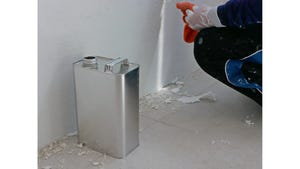Growing Nutraceutical Market – Shrinking Particle Sizes
March 24, 2015

Nutritional supplements have begun exiting the shadows of the vitamins market to become their own unique market segment. Nutritional supplements, such as those taken by health conscious work-out enthusiasts, take several forms like drink mixes, capsules, tablets, and gels. And the old, gold-standards of whey protein and creatine have made room for supplements containing amino acids, fish oil, anti-oxidants, and fatty acids, to name a few. This does not even touch on the vast array of vitamins and minerals that have seen an explosion in popularity over the last 20 years as people’s concern for health and fitness and the fight against age and illness continues.
The union of both the nutritional and pharmaceutical material has given rise to the concatenated term “nutraceutical” to describe these materials. By definition, nutraceuticals are food extracts that have been demonstrated to produce a physiological benefit or provide health and medical benefits beyond nutritional value and provide protection against chronic disease, delay the aging process, or increase life expectancy. To this end nutraceutical, pharmaceutical, and biotechnology companies have committed billions of dollars towards the research and development of commercially available products that are both biocompatible and bioavailable.
The Benefits of Using Mills for Particle Size Reduction
In order for nutraceuticals to be effective, a mill must be used to reduce the supplement powder to a low-micron particle size. The reduction of particle size leads to increased bioavailability, tight dosage control, and improved dispersability. Mills such as hammer mills, pin mills, air classifying mills, comminutors and conical mills, and others have been used successfully for decades to mill food ingredients, but not without their challenges.
The Unique Challenges of Milling Nutritional Supplements
Stickiness, abrasiveness, and hygroscopicity are three unique challenges of milling nutraceuticals that are generally made from food ingredients. The evolution in the market is the processing of these materials in a similar way to pharmaceuticals rather than food, which means that these materials must be made very fine in particle size, typically with d80 under 10µm with uniform particle shape to maximize the particle’s reactive surface, narrow distribution of particle size, and low contamination tolerance.
If nutraceuticals were just a food ingredient milling problem, the aforementioned types of mills are generally accepted for milling sticky and abrasive food ingredients. To solve problems with wide particle size distribution (PSD) with some of these technologies various screens and classifiers are employed and to solve contamination issues magnets and materials of construction changes are readily available. When the additional requirement of producing these materials in a pharmaceutical environment is presented, many of these technologies fall short. These types of mills were not designed for the narrow, low PSD of sub 10µm milling in a heat-free environment and can destroy valuable nutraceutical ingredients more commonly than they can mill them because most mechanical mills require a significant amount of attrition energy to be transferred to the material to produce very fine particles which results in waste heat and high wear, degrading the product and increasing contamination.
To handle the rapid expansion in nutraceutical demand, the question remains, what is the most practical and economical way to mill a material which has both the limitations of a food ingredient and a pharmaceutical ingredient? In an attempt to answer that question, many nutraceutical processors have targeted jet milling to solve the nutraceutical milling problem, but this is no easy task either.
Jet Mill Technology
A jet mill is a fluid energy mill that uses a series of jets to excite the nutraceutical into a rotating ring where the particles reduce themselves by particle-on-particle impact. The material travels at extremely high speed and causes very high collision forces to break apart the materials. Jet mill technology is well known to produce narrow particle size distributions as compared to other milling technologies. Achieving fineness of d100 less than 10 microns is common. As a single-step process the need for secondary screening or classifying is eliminated. In addition, jet milling does not produce heat which could potentially damage nutraceutical powders. However, for this technology to work correctly, materials must generally be friable, easily breakable, and not very sticky.
Surface Polishing and Liners
In a standard “pharmaceutical-grade” jet mill, contact surfaces are made from 316L stainless steel with a highly polished finish. In such a mill, the polish on mill contact surfaces allows for some “slipping” of the materials against the mill surfaces to prevent the sticky material from building up. However, over time, the abrasiveness of the nutraceutical will wear away the surface polish and cause microscopic porosity. The mill operator will then have to re-polish the mill on a regular basis to keep the mill operational. An alternative is to use mill liners. Liners are a regular feature of most mills and are sacrificial parts made to withstand the rigors of abrasiveness but again, nutraceuticals have the unique challenge of being both sticky and abrasive. The obvious first choice would be a ceramic liner such as aluminum oxide or silicon carbide. In these examples, the ceramic is an inert material and contamination of the finished material would be negligible. However, a ceramic liner is porous and over time, the sticky material will continue to build-up on the liner and the mill will continue to need service to keep it clean. More than a few customers have reported that their nutraceutical jet mill with ceramic liners must be cleaned every four hours. In a continuous processing environment, this option was ruled out due to the high cost of maintenance.
NASA Research Leads to Better Liner Materials
The challenge of lining a jet mill to handle both stickiness and abrasiveness led to research into exotic materials. One particular jet mill manufacturer turned to NASA, one of its customers for a solution. NASA has done extensive research into the rigors of space flight producing tremendous results in materials science. After working with materials scientists on several of these unique use cases, it was determined that ideal materials for the unique nutraceutical application already existed and were generally available, they simply needed to be applied to the application. Jet mill manufacturers now offer specialty liners made from exotic or proprietary materials and alloys which offer very unique properties that can be tailored to nutraceutical applications, as well as numerous other applications. There are now off-the-shelf jet mill liner options that offer high Rockwell hardness as well as high slip. After this extensive research, a jet mill manufacturer adopted a liner that offers improved performance over the polished 316L stainless steel pharmaceutical-grade jet mills because the material is much harder than steel, does not wear off significantly from abrasive material, is inert and approved by the FDA, and offers a smooth, non-porous surface to eliminate buildup. This liner material is also environmentally friendly and RoHS compliant. Using this material solves the abrasion, stickiness, hygroscopic problems of the food derived ingredient and performance in a jet mill solves the requirements of milling the material to a pharmaceutical grade and size.
Results
The operational requirements of the rapidly growing nutraceuticals industry demanded jet mill manufactures search for new liner options that are both wear resistant and prevent product build up but do not require frequent service or replacement. Research and development efforts continue to challenge manufacturers to identify new performance materials which outperform the existing materials and search for solutions to new and expanding requirements. Laboratory and site testing has demonstrated that the right balance of both hardness and nonstick properties is the ultimate solution for nutraceuticals and as new markets develop, the demand for new milling materials will only increase. Applications that once required daily cleaning now can operate maintenance free for weeks or more. Cleaning will always be part of routine maintenance for any mill technology however by addressing these challenges jet mill technology now offers manufactures the ability to efficiently produce superior product without risk of product contamination.
Rich Robatzek is product manager – Micronizer, Sturtevant Inc. (Hanover, MA). For more information, visit www.sturtevantinc.com.
Micronizer is a registered trademark of Sturtevant Inc.
For related articles, news, and equipment reviews, visit our Size Reduction Equipment Zone
You May Also Like

